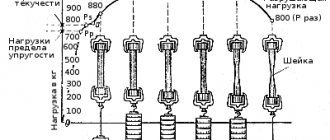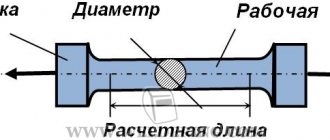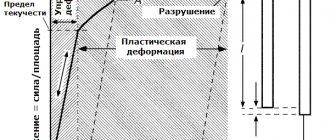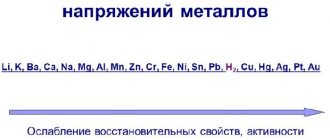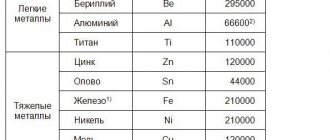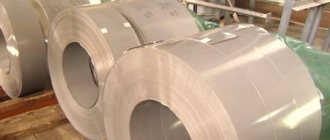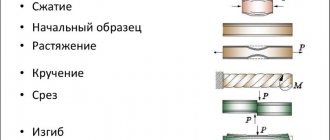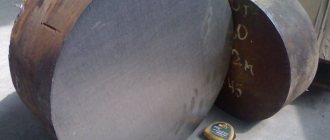The use of metals in everyday life began at the beginning of human development. Copper is their first representative. It is available in nature and is perfectly processed. During archaeological excavations, household items and various products made from it are often found.
In the process of development, man learned to combine different metals, producing alloys of greater strength. They were used to make tools and later used to make weapons. Experiments continue in our time, alloys with the specific strength of metals are being created, suitable for the construction of modern structures.
Types of deformation
Deformation is a modification of the configuration of a solid body under the influence of loads (external forces) applied to it. Deformations, after which the material returns to its previous shape and retains its original dimensions, are considered elastic, otherwise (the shape has changed, the material has lengthened) - plastic or residual. There are several types of deformation:
- Compression. The volume of the body decreases as a result of the action of compressive forces on it. The foundations of boilers and machines experience such deformation.
- Stretching. The length of a body increases when forces are applied to its ends, the direction of which coincides with its axis. Cables and drive belts are subject to stretching.
- Shift or shear. In this case, the forces are directed towards each other and, under certain conditions, shearing occurs. Examples are rivets and tie bolts.
- Torsion. A pair of forces, oppositely directed, acts on a body fixed at one end (shafts of engines and machine tools).
- Bend. Changes in the curvature of a body under the influence of external forces. This action is typical for beams, crane booms, and railway rails.
Determination of metal strength
One of the main requirements for metal used for the production of metal structures and parts is strength. To determine it, a metal sample is taken and stretched on a testing machine. The standard becomes thinner, the cross-sectional area decreases while its length increases. At a certain point, the sample begins to stretch in only one place, forming a “neck”. And after some time, a rupture occurs in the area of the thinnest place. Only ductile and brittle metals behave this way: hard steel and cast iron stretch only slightly and do not form a neck.
The load on the sample is determined by a special device called a force meter, which is built into the testing machine. To calculate the main characteristic of a metal, called the tensile strength of the material, it is necessary to divide the maximum load the sample can withstand before breaking by the cross-sectional area before tension. This value is necessary for the designer to determine the dimensions of the part to be manufactured, and for the technologist to assign processing modes.
Formation of the concept of the ultimate strength of metals
Galileo once spoke about the ultimate strength, who determined that the maximum permissible limit of compression and tension of materials depends on their cross-section. Thanks to the scientist's research, a previously unknown quantity arose - fracture stress.
The modern doctrine of the strength of metals was formed in the middle of the 20th century, which was necessary based on the need to develop a scientific approach to prevent possible destruction of industrial structures and machines during their operation. Until this point, when determining the strength of a material, only the degree of its plasticity and elasticity was taken into account and the internal structure was not taken into account at all.
The strongest metals in the world
High-strength metals include the following:
- Titanium. It has the following properties:
- high specific strength;
- low density;
- corrosion resistance;
- mechanical and chemical endurance.
resistance to elevated temperatures;
Titanium is used in medicine, military industry, shipbuilding, and aviation.
- Uranus. The most famous and durable metal in the world, it is a weak radioactive material. It is found in nature in pure form and in compounds. It is a heavy metal, flexible, malleable and relatively ductile. Widely used in industrial areas.
- Tungsten. Calculation of the strength of the metal shows that it is the most durable and refractory metal that is not susceptible to chemical attack. It is well forged and can be drawn into a thin thread. Used for filament.
- Rhenium. Refractory, has high density and hardness. Very durable, not subject to temperature changes. Finds application in electronics and technology.
- Osmium. Hard metal, refractory, resistant to mechanical damage and aggressive environments. Used in medicine, used for rocketry, electronic equipment.
- Iridium. It is rarely found in nature in free form, more often in compounds with osmium. It is difficult to machine, but has high resistance to chemicals and strength. Alloys with metal: titanium, chromium, tungsten, are used for making jewelry.
- Beryllium. A highly toxic metal with a relative density and a light gray color. Finds application in ferrous metallurgy, nuclear energy, laser and aerospace technology. It has high hardness and is used for alloying alloys.
- Chromium. A very hard metal with high strength, blue-white color, and is resistant to alkalis and acids. The strength of metal and alloys allows them to be used for the manufacture of medical and chemical equipment, as well as for metal-cutting tools.
- Tantalum. The metal is silver in color, has high hardness, strength, is refractory and resistant to corrosion, ductile, and easy to process. It is used in the creation of nuclear reactors, in metallurgy and the chemical industry.
- Ruthenium. Belongs to the platinum group metals. It has high strength, hardness, refractoriness, and chemical resistance. Contacts, electrodes, and sharp tips are made from it.
Alloying additives in alloys
These are substances deliberately added to the melt to improve the properties of the alloy and bring its parameters to the required ones. Some of them are added in large quantities (more than a percent), others in very small quantities. I most often use the following alloying additives:
- Chromium. Used to increase hardenability and hardness. Share – 0.8-0.2%.
- Bor. Improves cold brittleness and radiation resistance. Share – 0.003%.
- Titanium. Added to improve the structure of Cr-Mn alloys. Share – 0.1%.
- Molybdenum. Increases strength characteristics and corrosion resistance, reduces fragility. Share – 0.15-0.45%.
- Vanadium. Improves strength parameters and elasticity. Share – 0.1-0.3%.
- Nickel. Promotes an increase in strength characteristics and hardenability, but at the same time leads to an increase in fragility. This effect is compensated by the simultaneous addition of molybdenum.
Read also: How to make a wooden shovel
Metallurgists also use more complex combinations of alloying additives, achieving unique combinations of physical and mechanical properties of steel. The cost of such grades is several times (or even tens of times) higher than the cost of conventional low-carbon steels. They are used for particularly critical structures and assemblies.
If you find an error, please select a piece of text and press Ctrl+Enter.
Modern production requires a large number of durable steel products. Various steels are used in the construction of bridges, houses, and complex structures. One of the most important issues is the calculation of the strength of the metal and the stress value of the steel reinforcement. In order for structures to serve for a long time and be safe, it is necessary to accurately know the yield strength of the steel material that is subject to the main load.
How are the properties of metals determined?
To test metals for strength, chemical, physical and technological methods are used. Hardness determines how materials resist deformation. Resistant metal has greater strength and parts made from it wear out less. To determine hardness, a ball, diamond cone or pyramid is pressed into the metal. The hardness value is determined by the diameter of the imprint or the depth of indentation of the object. Stronger metal is less deformed and the depth of the imprint will be shallower.
But tensile samples are tested on tensile testing machines with a load that gradually increases during stretching. The standard can have a circle or square cross-section. To test the metal to withstand impact loads, impact tests are carried out. An incision is made in the middle of a specially made sample and placed opposite the impact device. Destruction must occur where the weak point is. When testing metals for strength, the structure of the material is examined using X-rays, ultrasound and powerful microscopes, and etching with chemicals is also used.
Technological tests include the simplest types of tests for destruction, ductility, forging, and welding. The extrusion test makes it possible to determine whether a sheet material is capable of cold forming. Using a ball, a hole is pressed into the metal until the first crack appears. The depth of the hole before fracture occurs will characterize the plasticity of the material. The bend test makes it possible to determine the ability of sheet material to take the desired shape. This test is used to evaluate the quality of welding seams. To assess the quality of the wire, a bend test is used. Pipes are tested for flattening and bending.
Catalog
- home
- Technical information
- Metals and alloys
- Requirements for metals
In order to assess the quality of materials and parts made from them, their behavior in specific units, parts and machines under changing operating conditions, to predict the use, repair and technical operation of machine-building and building structures, it is necessary to know their properties.
People understood this a long time ago. And a person in his practical activities, first by eye and touch, using the simplest tools, and then using complex instruments and techniques, checked the quality of objects and products of labor.
Thus, in 1722, Tsar Peter I issued a decree “On testing iron.” There were practically no instruments at that time, so tests had to be carried out using accessible and simple means. The main indicator was the destruction of metal during bending and impact. According to this decree, iron was sorted into three grades.
First try. The iron plate was bent and unbent three times around a pillar with a diameter of 6 inches (1 top = 4.45 cm) dug into the ground. If there are no breaks or cracks, then the iron is first-class.
Second try. If the iron did not withstand the first test (there are cracks or breaks), then subsequent tests were carried out, naturally, on a new sample, and not on the previously destroyed one. The iron strips were beaten against the anvil, first with one end three times, and then with the other end - also three times, and “those that survive, there will be no sign of a break, then put the mark No. 2.”
Third try. If the metal does not pass these two tests, then stamp No. 3 is placed next to the factory mark.
M.V. Lomonosov was the first to propose testing materials for friction and wear, and a special friction machine was made for this purpose. In 1897, international standards for testing metals were developed. The basis for calculating parts until the 20-30s of the 19th century was the indicators of static tests: yield strength, tensile strength and elastic modulus. In the 20–30s, the concepts of fatigue strength, fatigue limit under alternating loads, bending, torsion and tension-compression were introduced.
The quality of metals is a complex indicator (Fig. 1.9). It is impossible to evaluate quality by a separate indicator. For example, a metal may be very hard (good), but brittle and short-lived (bad). The complex of properties of metals can be divided into groups that provide answers to questions about their practical use (Table 1.1).
Table 1.1 Main groups of properties of metals.
| Properties of metals and alloys | What questions are answered? |
| Chemical composition | What's included? |
| Metal structure | How is it laid? |
| Physical characteristics (electrical conductivity, density, hardness, thermal conductivity, color, melting and crystallization temperatures, ...) | What are the physical properties of the material? |
| Mechanical properties (ductility, strength, toughness, elasticity,...) | What are the possibilities of using the material? |
| Technological properties (castability, malleability, weldability, cutting,…) | How to make a part? |
| Wear resistance, fatigue strength. corrosion resistance,... | What is the durability of a part made from the material? |
The properties of metals are determined by various methods: physical, chemical and technological.
Hardness
characterizes the resistance of materials to plastic deformation.
The higher the hardness, the greater the strength and less wear of the part
. This is especially important for working parts (paw, share, knife) of construction and road machines operating under abrasive (sand, crushed stone,...) wear conditions.
Hardness is determined by pressing a ball, diamond cone or diamond pyramid into the metal. The hardness value is characterized by the diameter of the indentation or the depth of penetration of the indenter (hardened ball, diamond cone or diamond pyramid). Naturally, the harder the material, the less its deformation will be, and, accordingly, the smaller the diameter and depth of the imprint). The three main methods for determining hardness are most often used: Brunelle, Rockwell and Vickers.
When determining hardness (Fig. 1.10) according to Brinell
A hardened steel ball with a diameter of D = 2.5 is pressed into the surface being tested; 5 or 10 mm with loads ranging from 0.625...30 kN. Next, the diameter of the print is measured.
The Brunelle hardness number is the ratio of the load P (in kgf) to the area F (in mm2) of the print surface:
НВ = Р/ F =2Р/pD kgf/mm2.
In its physical essence, Brinell hardness is a stress and expresses resistance to plastic deformation.
There is a linear relationship between the hardness and strength of a material:
for steels and aluminum alloys - sв = 0.35 НВ;
for copper alloys - sв = 0.45 НВ.
The diameter of the ball D is selected depending on the thickness h of the part: D = 2.5 mm - h < 3 mm;
D = 5 mm - h = 3...6 mm;
D = 10 mm - h > 6 mm.
The load value P (in kgf) depends not only on the diameter of the ball D, but also on the material of the part. For harder materials, a greater load is required, so in the formulas below, the coefficient for steel (30) is greater than for softer materials (10 for bronze and brass; 2.5 for tin):
P = 30 D2 - steel, cast iron;
P = 10 D2 - bronze, brass;
P = 2.5 D2 - tin, lead and other soft metals.
Examples of Brinell hardness designation: 185НВ, 200НВ, 86НВ. The higher the number, the greater the hardness of the material (200HB > 86HB).
Vickers hardness of metals
(Fig. 1.11) is determined in the same way as according to Brinell, but instead of a ball a diamond 4-sided pyramid is used:
HV = P / F = 1.8544 P / d 2, kgf / mm2,
where F, d are the surface and diagonal of the print;
P is the load on the pyramid, kgf.
Diagonal d is determined using a microscope mounted directly into the device. This method is used for small parts and for scientific research. The hardness values of materials determined by Brunell (HB) and Vickers (HV) are the same. Examples of Vickers hardness designation: HV180, HV 295.
When determining Rockwell
(Fig. 1.12) a diamond cone (cone angle 120°) or a hardened steel ball with a diameter of 1.6 mm is pressed into the metal under test under a certain load: first preliminary P = 10 kgf, then main - 60, 100 or 150 kgf. The device has three scales A, B and C to report the corresponding hardness HRA, HRB and HRC. The Rockwell hardness number characterizes the penetration depth of the indenter (ball or cone) under a certain load (60, 100 or 150 kgf). Hardness HRC, HRA, HRB is determined by formulas corresponding to the modes of its determination (type of indenter and load value):
HRC=100 –e (diamond cone, Р= 150 kgf);
HRA=100 –e (diamond cone, P= 60 kgf);
HRВ=130 –e (ball, Р= 100 kgf),
in which e = 0.002 h2 » 0.002 (h1-h0).
Consequently, Rockwell hardness is a dimensionless quantity, the unit of which corresponds to the depth of movement of the indenter by 0.002 mm. Examples of Rockwell hardness designations: 47HRC, 23HRC, 30HRC, 80HRA, 30HRB.
The hardness designation shows its value and determination mode (diamond cone or ball; load: 60,100 or 150 kgf). For comparison, the hardness of the crankshaft journal of a diesel engine (47...52HRC) is significantly higher than the hardness of the piston pin (30...32HRC).
Tensile testing of samples (Fig. 1.13) (Fig. 1.14) is carried out on tensile testing machines under a gradually increasing tensile load. Samples are made of round or square cross-section. The magnitude of the force acting in the cross section of the sample is converted into a stress value expressed in newtons (or kilograms) per square millimeter. At low loads (and therefore low stresses), residual deformation does not occur and the sample, after removing the load, takes on its initial length, i.e. he behaves elastically. In the region of 0...A elastic deformation, the latter is directly proportional to stress, i.e. if the stress doubles, then the elastic deformation doubles. The initial section of the diagram is a straight line. The steepness of this section (the ratio of stress to strain) is a characteristic of the metal - Young's modulus of elasticity (modulus E).
In the yield range (B...C), the sample elongates at a constant load P. When the load is removed in this interval (B...C), the sample does not return to the initial length, but becomes longer - in accordance with the proportion of the plastic deformation of the total. In section B...C, the material is strengthened and, as a consequence, after point B, the length of the sample increases with increasing tensile load. Further, the load increases to a maximum Рв, after which a local narrowing of the sample occurs and a “neck” is formed. Further, the size of the neck increases, the tensile load decreases, but so does the cross-section, and at point K the sample breaks.
The tensile curve allows you to determine several important characteristics of the metal. First of all, this is the tensile strength sв, i.e. maximum stress that the sample can withstand without necking, relative elongation d.
The conditional yield strength s0.2 is the stress at which the elongation of the sample is 0.2% of the calculated length.
Tensile strength is determined from the relationship:
sв = Рв/Fo, kgf/mm2,
where Fo is the initial cross-sectional area of the sample, mm2,
Рв – tensile strength load, kgf.
True breaking resistance s
z is the stress corresponding to the ratio of the load at the moment of rupture to the cross-sectional area of the sample at the point of rupture:
sz = Pz/Fk,
where Fk is the final cross-sectional area of the sample.
Plasticity is a change in the dimensions of a sample without breaking the continuity of the material.
Relative elongation d is found by the formula (in%):
d= 100 (Lk - L0) / L0,
where L0, Lк is the length of the sample before and after rupture.
The relative narrowing y (in %) is the ratio:
y = 100 (Fo - Fk) / Fo.
From the initial section of the curve, the elastic modulus of the material E is found. According to Hooke’s law
s = P / Fo = E ´ DL / L0
The values of the elastic modulus can be determined geometrically as the tangent of the angle of inclination a of the initial section of the tension diagram:
E = tga
In many cases, we are interested not just in absolute values of strength, but in specific strength, i.e. the ratio of strength to density g (specific gravity) of the material (Table 1.2).
Table 1.2 Comparative characteristics of strength and stiffness of various materials.
| Material | Strength, sв, kgf/mm2 | Specific strength, sв/g ´ 105 | Specific hardness, (E/g) 1/3 |
| Structural steel | 450…1100 | 6…15 | — |
| Alloy steel | 1100…1400 | 15…19 | 3,3…3,5 |
| High strength steel | 1800…2000 | 22…25 | — |
| Aluminium alloy | 420…600 | 16…21 | 6,8…6,9 |
| Titanium alloys | 1200…1400 | 26…40 | 4,8…5,1 |
| Fiberglass | > 700 | 38…50 | 7…7,2 |
The ability of a metal to withstand impact loads is determined during impact tests (Fig. 1.15). For this purpose, a special sample is made. An incision is made in the middle of it, which is necessary so that destruction occurs at the weakest point, i.e. at the cut point installed opposite the impact device of the pendulum pile driver.
The work An on sample destruction is defined as the difference between the potential energy of the load before testing (P´H) and the remaining potential energy (P´h) after destruction of the sample:
An = P (H - h).
Impact strength an represents the specific work required to destroy a unit area of a sample:
an = An/Fo,
where Fo is the cross-sectional area of the sample at the notch location.
Dynamic tests make it possible to identify the tendency of metals to brittle fracture (Fig. 1.16). Based on the amount of fiber in the fracture (visually by the matte fibrous component), the type of fracture is assessed: ductile fracture (90% of fibers), brittle fracture (only 10% of fibers) and mixed fracture.
The threshold for cold brittleness (a very important characteristic of a metal, especially for the natural and climatic conditions of the Tyumen region) is taken to be the temperature at which there is about 50% of the fiber, which approximately corresponds to the value ½an. For critical parts, the critical cold brittleness temperature is considered to be the temperature at which 90% of the fibers are present. The value of impact strength an is not a constant value, but strongly depends on its structure, test conditions, the presence of stress concentrators, etc.
Fatigue tests
In real operating conditions, the loads on some parts change both in magnitude and direction, as a result of which microcracks appear in the metal, then they develop and, at relatively small loads, metal destruction occurs (part failure). Crankshafts, connecting rods, gears, leaf springs and many other parts fail most often for these reasons.
In Fig. Figure 1.17 shows a cantilever shaft, when rotating in the fillet sections, the load per revolution will change from maximum to zero. As a result of repeatedly repeated loading cycles, individual microcracks first form in the most dangerous place (fillets), then they increase in size and merge with each other, forming larger cracks, and at relatively small loads (compared to the initial operating conditions), the shaft is destroyed along the fillet.
In Fig. 1.18. the fatigue curve is shown. During testing, the number of loading cycles until failure of a metal sample at various stresses is determined. The stress s-1 is called the fatigue limit, i.e. This is the value of the stress at which there is no fatigue failure. Typically, tests are not carried out until this horizontal section appears, but are completed for steel samples at 5 ´ 106 cycles and for samples made of non-ferrous alloys at a larger (20 ´ 106) number of cycles.
In this case, the fatigue limit is the limiting stress at which the sample does not fail for a given number of cycles.
The structure of metals is studied in several ways. The internal structure of the crystal lattice (phase composition, grain size, etc.) is studied using the X-ray diffraction method. When examined with ultrasound or x-rays, the quality of casting and welding is determined by the presence of cracks, slag inclusions and cavities .
The macrostructure of the metal (grain size, direction of fibers in deformed layers of metal, the presence of shrinkage and gas cracks, the nature of the fracture of the part) is determined by the naked eye. by eye or with magnification (magnifying glass, microscope) up to 30 times. The surface is first sanded with sandpaper, and then deeply etched with chemical solutions.
For microscopic examination, microscopes with a magnification of 50...2000 times are used. Metal sections are prepared in the form of cylinders (10...15 mm in diameter and height), or in the form of cubes 10´10 mm. The metal is ground, polished and etched in weak acid solutions. Due to the unequal etching of structural components, grains and their boundaries, a microrelief appears on the surface of the metal. A combination of light and shadow is created. A more etched structure will appear darker in the microscope compared to a less etched structure.
Technological tests are the simplest types of testing materials for ductility and fracture, for the possibility of forging, bending, welding, etc.
Thus, the extrusion test determines the ability of sheet material to be cold formed. Using a punch (ball), the holes are squeezed out until the first crack appears. The depth of the hole before failure characterizes the plasticity of the material.
The bending test of sheet material in a cold and hot state determines its ability to take a given shape. The bending test evaluates the quality of welds. The strength characteristic is the deflection angle before the weld fails. Double roof lock test. carried out for sheet metal with a thickness of less than 0.8 mm. The bend angle, the number of bends and extensions are assessed.
Bend test (repeated bending and unbending) evaluates the quality of the wire. Bending and flattening tests are carried out for pipes with a diameter of less than 115 mm; the hole is filled with dry sand, then the pipe is bent 90 degrees around the mandrel.
The cold slump test checks the materials used for manufacturing. bolts and rivets.
A test by winding a wire onto a mandrel is carried out to determine the possibility of obtaining a given number of turns.
Mechanical properties of metals and alloys
The mechanical properties of metal materials include the following:
- Strength. It lies in the ability of a material to resist destruction under the influence of external forces. The type of strength depends on how external forces act. It is divided into: compression, tension, torsion, bending, creep, fatigue.
- Plastic. This is the ability of metals and their alloys to change shape under load without being destroyed, and to retain it after the end of the impact. The ductility of a metal material is determined by stretching it. The more elongation occurs, while the cross-section decreases, the more ductile the metal. Materials with good plasticity are perfectly processed by pressure: forging, pressing. Plasticity is characterized by two quantities: relative narrowing and elongation.
- Hardness. This quality of the metal lies in its ability to resist the penetration of a foreign body that has greater hardness into it, without resulting in residual deformations. Wear resistance and strength are the main characteristics of metals and alloys, which are closely related to hardness. Materials with such properties are used for the manufacture of tools used for metal processing: cutters, files, drills, taps. Often, the hardness of a material determines its wear resistance. Thus, hard steels wear out less during operation than softer grades.
- Impact strength. The peculiarity of alloys and metals is to resist the influence of loads accompanied by impact. This is one of the important characteristics of the material from which parts that experience impact loads are made during machine operation: wheel axles, crankshafts.
- Fatigue. This is the state of a metal that is under constant stress. Fatigue of the metal material occurs gradually and can result in the destruction of the product. The ability of metals to resist failure due to fatigue is called endurance. This property depends on the nature of the alloy or metal, the state of the surface, the nature of the processing, and operating conditions.
Strength classes and their designations
Regulatory documents on the mechanical properties of fasteners introduced the concept of metal strength class and established a designation system. Each strength class is indicated by two numbers, between which a dot is placed. The first number means the tensile strength reduced by 100 times. For example, a strength class of 5.6 will mean that the tensile strength will be 500. The second number is increased by 10 times - this is the ratio of the yield strength to the tensile strength, expressed as a percentage (500x0.6 = 300), i.e. 30% is the minimum yield strength of tensile strength. All products used for fastening are classified according to their intended use, shape, material used, strength class and coating. According to their intended use, they are:
- Ploughshares. They are used for agricultural machines.
- Furniture. Used in construction and furniture production.
- Road. They fasten metal structures.
- Mechanical engineering. Used in the mechanical engineering industry and instrument making.
The mechanical properties of fasteners depend on the steel from which they are made and the quality of processing.
Tensile strength of steel
Steel is the main raw material in most industrial applications. It is widely used in construction. That is why it is very important to select in advance a high-quality, truly suitable type of steel to perform specific tasks. The result and quality of the work performed directly depends on the correct calculation of the tensile strength of a certain steel grade.
As an example, we can cite several values of the ultimate strength indicators of steels. These values are based on government standards and are recommended parameters. Thus, for products cast from structural non-alloy steel, the GOST 977-88 standard is provided, according to which the limiting strength value during tensile testing is about 50-60 kg/mm 2, which is approximately 400-550 MPa. A similar grade of steel, after undergoing the hardening procedure, acquires a tensile strength value of more than 700 MPa.
The objective tensile strength of steel 45 (or any other grade of material, just like iron or cast iron, as well as other metal alloys) depends on a number of factors that must be determined based on the tasks assigned to the material during its use.
Specific strength
The specific strength of a material (formula below) is characterized by the ratio of the tensile strength to the density of the metal. This value shows the strength of the structure for a given mass. It is of greatest importance for such industries as aircraft manufacturing, rocketry and spacecraft production.
In terms of specific strength, titanium alloys are the strongest of all technical materials used. Titanium alloys have twice the specific strength of metals classified as alloy steels. They are not susceptible to corrosion in air, in acidic and alkaline environments, are not afraid of sea water and have good heat resistance. At high temperatures, their strength is higher than that of alloys with magnesium and aluminum. Due to these properties, their use as a structural material is constantly increasing and is widely used in mechanical engineering. The disadvantage of titanium alloys is their low machinability. This is due to the physical and chemical properties of the material and the special structure of the alloys.
Above is a table of the specific strength of metals.
Using the plasticity and strength of metals
Very important properties of metal are ductility and strength. These properties are directly dependent on each other. They do not allow the metal to change shape and prevent macroscopic destruction when exposed to external and internal forces.
Metals with high ductility are destroyed gradually under load. At first they have a bend and only then does it begin to gradually collapse. Ductile metals easily change shape, which is why they are widely used to make car bodies. The strength and ductility of metals depends on the direction of the forces applied to it and in which direction the rolling was carried out during the manufacture of the material. It has been established that when rolling, metal crystals elongate in its direction more than in the transverse direction. Sheet steel has much greater strength and ductility in the rolling direction. In the transverse direction, strength decreases by 30%, and ductility by 50%; along the thickness of the sheet, these figures are even lower. For example, the appearance of a fracture on a steel sheet during welding can be explained by the parallelism of the weld axis and the rolling direction. Based on the ductility and strength of a material, the possibility of its use for the manufacture of various parts of machines, structures, tools, and devices is established.
Methods for determining strength: destructive method and non-destructive testing methods
Author: Konstantin Vavilov · Published 10/18/2017 · Updated 04/28/2018
Strength is the ability of a material, machine parts, building structure elements, etc., to resist internal stresses arising under the influence of external load. In this article we will definitely talk about internal stresses, how they are determined and what they should be in order for the strength of the material to be ensured. In this article, I will talk in more detail about what strength is, what types and methods exist for calculating strength for the simplest types of deformation: tension and compression, torsion and bending. I’ll tell you about the concept of “safety factor”. I will provide information on the theories of strength and modern methods of calculating parts and structures for strength using a computer, in particular, software products for solving engineering problems CAE.
Standard and design resistance of metal
One of the main parameters that characterize the resistance of metals to force is the standard resistance. It is installed according to design standards. The calculated resistance is obtained by dividing the standard resistance by the corresponding reliability factor for a given material. In some cases, the coefficient of operating conditions of structures is also taken into account. In calculations of practical importance, the calculated resistance of the metal is mainly used.
Ways to increase the strength of metal
There are several ways to increase the strength of metals and alloys:
- Creation of alloys and metals with a defect-free structure. There are developments for the production of whiskers (whiskers) that are several tens of times stronger than ordinary metals.
- Obtaining volumetric and surface hardening by artificial means. When metal is processed by pressure (forging, drawing, rolling, pressing), volumetric hardening is formed, while knurling and shot blasting produces surface hardening.
- Creation of alloy metal using elements from the periodic table.
- Purification of metal from impurities present in it. As a result, its mechanical properties are improved and the propagation of cracks is significantly reduced.
- Removing roughness from the surface of parts.
Interesting Facts
- Titanium alloys, the specific weight of which exceeds aluminum by about 70%, are 4 times stronger than them, therefore, in terms of specific strength, alloys containing titanium are more profitable to use for aircraft construction.
- Many aluminum alloys exceed the specific strength of steels containing carbon. Aluminum alloys have high ductility, corrosion resistance, and can be easily processed by pressure and cutting.
- Plastics have a higher specific strength than metals. But due to insufficient rigidity, mechanical strength, aging, increased fragility and low heat resistance, layered plastics, textolites and getinaks are limited in their use, especially in large-sized structures.
- It has been established that in terms of resistance to corrosion and specific strength, ferrous, non-ferrous metals and many of their alloys are inferior to fiberglass.
The mechanical properties of metals are the most important factor in their use for practical needs. When designing a structure, part or machine and selecting a material, be sure to consider all the mechanical properties that it possesses.
Aluminum strength
The annealed fraction of technical aluminum at room temperature has a tensile strength of up to 8 kg/mm 2. Increasing the purity of the material increases its ductility, but is reflected in a decrease in strength. An example is aluminum, which has a purity of 99.99%. In this case, the ultimate strength of the material reaches about 5 kg/mm 2.
A decrease in the tensile strength of an aluminum dough piece is observed when it is heated during tensile testing. In turn, lowering the metal temperature in the range from +27 to -260 o C temporarily increases the test indicator by 4 times, and when testing the highest purity aluminum fraction - by as much as 7 times. At the same time, the strength of aluminum can be slightly increased by alloying it.
